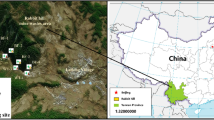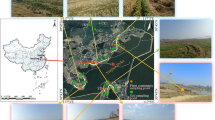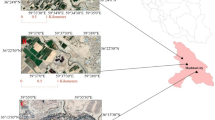Abstract
This study at Indian Sundarbans, identifies metal tolerant mangroves with phytoremediation potential by understanding the affect of metal pollution on the community structure of this estuarine ecosystem. Community study indicates that polluted site has lower relative density of the true mangrove and four metal tolerant species (Cryptocoryne ciliata, Heliotropium currasavicum, Hemarthria altissima and Avicennia officinalis) are predominant with 72 % of relative density. Biodiversity indices (Simpson’s index of Dominance and Diversity, Shannon-Weiner index) indicate reduction in diversity and increase in dominance of metal tolerance species at the polluted site. The cluster/components originating after cluster and principal component analysis shows that Cr, Pb, Cd and Ni are metal pollutants of anthropogenic origin. Metal accumulation study is conducted on these four species after assessing the status of metal pollution in their rhizospheres using Ecological risk index, Geoaccumulation index, Enrichment factor and Contamination factor. Bioaccumulation factor emphasized that C. ciliata has a high potential for extracting Cd, Cr and Pb. Bioconcentration factor of Cr is high for A. officinalis, C. ciliata (potentially invasive) and H. altissima (invasive species) whereas translocation factor indicates Cd, Ni and Zn can be translocated to the aerial part of these plants. In addition, H. altissima also transfer Cr and Pb to their aerial parts. This study concluded that C. ciliata could be used as phytoextracter for Cd, Cr and Pb in metal contaminated mangrove ecosystem.








Similar content being viewed by others
References
Aksoy A, Demirezen D, Duman F (2005) Bioaccumulation, detection and analyses of heavy metal pollution in Sultan Marsh and its environment. Water Air Soil Pollut 164(1–4):241–255
Alloway BJ (2013) Heavy metals in soils: trace metals and metalloids in soils and their bioavailability. Environ Pollut 22 (Springer, Dordrecht). doi:10.1007/978-94-007-4470-7_12
Alongi DM (2008) Mangrove forests: resilience, protection from tsunamis, and responses to global climate change. Estuar Coast Shelf Sci 76(1):1–13
An Q, Wu Y, Wang J, Li Z (2009) Heavy metals and polychlorinated biphenyls in sediments of the Yangtze river estuary, China. Environ Earth Sci 59:363–370
Aston EC, Macintosh DJ (2002) Preliminary assessment of the plant diversity and community ecology of Sematan mangrove forest, Sarawak, Malaysia. For Ecol Manag 166(1):111–129
Babula P, Adam V, Opatrilova R, Zehnalek J, Havel L, Kizek R (2008) Uncommon heavy metals, metalloids and their plant toxicity: a review. Environ Chem Lett 6(4):189–213
Banerjee S, Maiti SK, Kumar A (2015) Metal contamination in water and bioaccumulation of metals in the planktons, molluscs and fishes in Jamshedpur stretch of Subarnarekha River of Chotanagpur Plateau, India. Water Environ J 29(2):207–213
Banerjee S, Kumar A, Maiti SK, Chowdhury A (2016) Seasonal variation in heavy metal contaminations in water and sediments of Jamshedpur stretch of Subarnarekha river, India. Environ Earth Sci 75 (3):1–12
Bhuiyan MAH, Suruvi NI, Dampare SB, Islam MA, Quraishi SB, Ganyaglo S, Suzuki S (2011) Investigation of the possible sources of heavy metal contamination in lagoon and canal water in the tannery industrial area in Dhaka, Bangladesh. Environ Monit Assess 175(1–4):633–649
Biswas SR, Choudhury JK, Nishat A, Rahman MM (2007) Do invasive plants threaten the Sundarbans mangrove forest of Bangladesh? For Ecol Manag 245:1–9
Clemens S, Palamgren MG, Krämer U (2002) A long way ahead: understanding and engineering plant metal accumulation. Trends Plant Sci 7(7):309–315
Comeaux RS, Allison MA, Bianchi TS (2012) Mangrove expansion in the Gulf of Mexico with climate change: implications for wetland health and resistance to rising sea levels. Estuar Coast Shelf Sci 96:81–95
Das M, Maiti SK (2008) Comparison between availability of heavy metals in dry and wetland tailing of an abandoned copper tailing pond. Environ Monit Assess 137(1–3):343–350
Dasgupta R, Shaw R (2015) An indicator based approach to assess coastal communities’ resilience against climate related disasters in Indian Sundarbans. J Coast Conserv 19(1):85–101
Defew LH, Mair JM, Guzman HM (2005) An assessment of metal contamination in mangrove sediments and leaves from Punta Mala Bay, Pacific Panama. Mar Pollut Bull 50(5):547–552
Donato CD, Kauffman JB, Murdiarso D, Kurnianto S, Stidham M, Kanninen M (2011) Mangroves among the most carbon-rich forests in the tropics. Nat Geosci. doi:10.1038/NGEO1123
Duke N, Ball M, Ellison J (1998) Factors influencing biodiversity and distributional gradients in mangroves. Glob Ecol Biogeogr Letters 7(1):27–47
Duke NC, Meynecke JO, Dittmannetal S (2007) A world without mangroves? Science 317(5834):41–42
Ellison AM, Farnsworth EJ (1993) Seedling survivorship, growth, and response to disturbance in Belizean Mangal. Am J Bot 80(10):1137–1145
Ellison AM, Mukherjee BB, Karim A (2000) Testing patterns of zonation in mangroves: scale dependence and environmental correlates in the Sundarbans of Bangladesh. J Ecol 88(5):813–824. doi:10.1046/j.1365-2745.2000.00500.x
El-Said GF, Youssef DH (2013) Ecotoxicological impact assessment of some heavy metals and their distribution in some fractions of mangrove sediments from Red Sea, Egypt. Environ Monit Assess 185(1):393–404
Fernandes MC, Nayak GN, Pande A, Volvoikar SP, Dessai DRG (2014) Depositional environment of mudflats and mangroves and bioavailability of selected metals within mudflats in a tropical estuary. Environ Earth Sci 72:1861–1875
Fischer L, Brummer GW, Barrow NJ (2007) Observations and modelling of the reactions of 10 metals with goethite: adsorption and diffusion processes. Eur J Soil Sci 58:1304–1315
Freitas H, Prasad MNV, Pratas J (2004) Plant community tolerant to trace elements growing on the degraded soils of São Domingos mine in the south east of Portugal: environmental implications. Environ Int 30(1):65–72
Ghannem N, Gargouri D, Sarbeji MM, Yaich C, Azri C (2014) Metal contamination of surface sediments of the Sfax-Chebba coastal line, Tunisia. Environ Earth Sci 72:3419–3427
Giri S, Mukhopadhay A, Hazra S, Mukherjee S, Roy D, Ghosh S, Ghosh T, Mitra D (2014) A study on abundance and distribution of mangrove species in Indian Sundarban using remote sensing technique. J Coast Conserv 18(4):359–367
Guhathakurta H, Kaviraj A (2000) Heavy metal concentration in water, sediment, shrimp (Penaeus monodon) and mullet (Liza parsia) in some brackish water ponds of Sunderban, India. Mar Pollut Bull 40(11):914–920
Hakanson L (1980) An ecological risk index for aquatic pollution control. A sedimentological approach. Water Res 14(8):975–1001
Harbison P (1986) Mangrove muds: a sink or source for trace metals. Mar Pollut Bull 17(6):246–250
Haris H, Aris AZ (2015) Distribution of metals and quality of intertidal surface sediment near commercial ports and estuaries of urbanized rivers in Port Klang, Malaysia. Environ Earth Sci 73:7205–7218
Hejabi AT, Basavarajappa HT, Karbassi AR, Monavari SM (2011) Heavy metal pollution in water and sediments in the Kabini River, Karnataka. India. Environ Monit Assess 182(1–4):1–13
Hernández A, Pastor J (2008) Relationship between plant biodiversity and heavy metal bioavailability in grasslands overlying an abandoned mine. Environ Geochem Health 30(2):127–133
Ianni C, Ruggieri N, Rivaro P, Frache R (2001) Evaluation and comparison of two selective extraction procedures for heavy metal speciation in sediments. Anal Sci 17:1273–1278
Jackson ML (1973) Soil chemical analysis. Prentice Hall, New Delhi
Kabata-Pendias A, Pendias H (2001) Trace elements in soils and plants, 3rd edn. CRC Press, London
Kumar A, Maiti SK (2014) Translocation and bioaccumulation of metals in Oryza sativa and Zea mays growing in chromite-asbestos contaminated agricultural fields, Jharkhand, India. Bull Environ Contam Toxicol 93(4):434–441
Kumar A, Maiti SK (2015) Assessment of potentially toxic heavy metal contamination in agricultural fields, sediment, and water from an abandoned chromite-asbestos mine waste of Roro Hill, Chaibasa, India. Environ Earth Sci 74(3):1–17
Kumar G, Kumar M, Ramanathan AL (2015) Assessment of heavy metal contamination in the surface sediments in the mangrove ecosystem of Gulf of Kachchh, West Coast of India. Environ Earth Sci 74:545–556
Lacerda ID, Fernandez MA, Calazans CF, Tanizaki KF (1992) Bioavailability of heavy metals in sediments of two coastal lagoons in Rio de Janeiro, Brazil. Hydrobiologia 228(1):65–70
Laude R (1996) Statistics and partitioning of species diversity, and similarity among multiple communities. Oikos 76:5–13
Liu W-X, Shen L-F, Liu J-W, Wang Y-W, Li S-R (2007) Uptake of toxic heavy metals by rice (Oryza sativa L.) cultivated in the agricultural soil near Zhengzhou City, People’s Republic of China. B Environ Contam Toxic 79(2):209–213
Ma H, Hua L, Ji J (2011) Speciation and phytoavailability of heavy metals in sediments in Nanjing section of Changjiang River. Environ Earth Sci 64(1):185–192
MacFarlane GR, Pulkownik A, Burchett MD (2003) Accumulation and distribution of heavy metals in the grey mangrove, Avicennia marina (Forsk.)Vierh.: biological indication potential. Environ Pollut 123(1):139–151
MacFarlane GR, Koller CE, Blomberg SP (2007) Accumulation and partitioning of heavy metals in mangroves: a synthesis of field-based studies. Chemosphere 69(9):1454–1464
Magesh NS, Chandrasekar N, Roy DV (2011) Spatial analysis of trace element contamination in sediments of Tamiraparani estuary, southeast coast of India. Estuar Coast Shelf Sci 92(4):618–628
Maiti SK (2013) Ecorestoration of the coalmine degraded lands. Springer, New York. doi:10.1007/978-81-322-0851-8
Maiti SK, Nandhini N (2006) Bioavailability of metals in fly ash and their bioaccumulation in naturally occurring vegetation. Environ Monit Assess 116 (1–3):263–273
Maiti SK, Jaiswal S (2008) Bioaccumulation and translocation of metals in the natural vegetation growing on fly ash lagoons: a field study from Santaldih thermal power plant, West Bengal, India. Environ Monit Assess 136:355–370
Manjunatha BR, Balakrishna K, Shankar R, Mahalingam TR (2001) Geochemistry and assessment of metal pollution in the soils and river components of a monsoon dominated environment near Karwar, southwest coast of India. Environ Geol 40:1462–1470
Manousaki E, Kalogerakis N (2011) Halophytes—an emerging trend in phytoremediation. Int J Phytoremediat 13(10):959–969
Marchand C, Lallier-Verges E, Baltzer F, Alberic P, Cossa D, Baillif P (2006) Heavy metals distribution in mangrove sediments along the mobile coastline of French Guiana. Mar Chem 98(1):1–17
McCartney M (2009) Living with dams: managing the environmental impacts. Water Policy 11:121–139
Mwinyihija M (2010) Main pollutants and environmental impacts of the tanning industry. In: Ecotoxicological diagnosis in the tanning industry. Springer, New York, pp 17–35
Natesan U, Kumar MM, Deepthi K (2014) Mangrove sediments a sink for heavy metals? An assessment of Muthupet mangroves of Tamil Nadu, southeast coast of India. Environ Earth Sci 72(4):1255–1270
Nirel PMV, Morel FMM (1990) Pitfalls of sequential extractions. Water Res 24(8):1055–1056
Ogwueleka TC (2014) Assessment of the water quality and identification of pollution sources of Kaduna River in Niger State (Nigeria) using exploratory data analysis. Water Environ J 28(1):31–37
Peijnenburg WJ, Zablotskaja M, Vijver MG (2007) Monitoring metals in terrestrial environments within a bioavailability framework and a focus on soil extraction. Ecotox Environ Safe 67(2):163–179
Rahman MS, Saha N, Molla AH (2014) Potential ecological risk assessment of heavy metal contamination in sediment and water body around Dhaka export processing zone, Bangladesh. Environ Earth Sci 71(5):2293–2308
Ruilian YU, Xing YUAN, Yuanhui ZHAO, Gongren HU, Xianglin TU (2008) Heavy metal pollution in intertidal sediments from Quanzhou Bay. China. J Environ Sci 20(6):664–669
Shannon CE (1948) A mathematical theory of communication. Bell Syst Tech J 27:379–656
Sharma A, Gontia I, Agarwal PK, Jha B (2010) Accumulation of heavy metals and its biochemical responses in Salicornia brachiata, an extreme halophyte. Mar Biol Res 6(5):511–518
Silva CAR, Lacerda LD, Rezende CE (1990) Heavy metal reservoirs in a red mangrove forest. Biotropica 22:339–345
Simpson EH (1949) Measurement of diversity. Nat 163:688
Singh KP, Malik A, Mohan D, Sinha S (2004) Multivariate statistical techniques for the evaluation of spatial and temporal variations in water quality of Gomti River (India)—a case study. Water Res 38(18):3980–3992
Singh R, Singh DP, Kumar N, Bhargava SK, Barman SC (2010) Accumulation and translocation of heavy metals in soil and plants from fly ash contaminated area. J Environ Biol 31(4):421–430
Smith TM, Smith RL (2012) Elements of ecology, 3rd edn. Pearson, Glenview
Srivastava PK, Mukherjee S, Gupta M, Singh SK (2011) Characterizing monsoonal variation on water quality index of River Mahi in India using geographical information system. Water Qual Expo Health 2(3–4):193–203
Tam NFY, Wong WS (2000) Spatial variation of heavy metals in surface sediments of Hong Kong mangrove swamps. Environ Pollut 110(2):195–205
Turekin KK, Wedepohl KH (1961) Distribution of the elements in some major units of the earth’s crust. Geol Soc Am Bull 72(2):175–192
Walkley A, Black IA (1934) An examination of the Degtjareff method for determining soil organic matter and a proposed modification of the chromic acid titration method. Soil Sci 37:29–38
Wang R, Dai S, Tang S, Tian S, Song Z, Deng X, Ding Y, Zou Y, Smith DL (2012) Growth, gas exchange, root morphology and cadmium uptake responses of poplars and willows grown on cadmium-contaminated soil to elevated CO2. Environ Earth Sci 67(1):1–13
Yoon J, Cao X, Xao Q, Ma LQ (2006) Accumulation of Pb, Cu, and Zn in native plants growing on a contaminated Florida site. Sci Total Environ 368(2):456–464
Zhang D, Zhang X, Tian L, Ye F, Huang X, Zeng Y, Fan M (2013) Seasonal and spatial dynamics of trace elements in water and sediment from Pearl River Estuary, South China. Environ Earth Sci 68(4):1053–1063
Zhang G, Pan Z, Hou X, Wang X, Li X (2014) Distribution and bioaccumulation of heavy metals in food web of Nansi Lake, China. Environ Earth Sci 73(5):2429–2439
Zhou YW, Peng YS, Li XL, Chen GZ (2011) Accumulation and partitioning of heavy metals in mangrove rhizosphere sediments. Environ Earth Sci 64:799–807
Acknowledgments
The first author is indebted to Indian School of Mines and MHRD, India to provide fellowship (Regestration no: 2013DR0015) and Department of Environmental Science and Engineering, for providing necessary laboratory facilities for this study. We acknowledge the support provided by Mr. T.K. Sinha (senior technical assistant) at the department during the laboratory analysis of the samples.
Author information
Authors and Affiliations
Corresponding author
Rights and permissions
About this article
Cite this article
Chowdhury, A., Maiti, S.K. Identification of metal tolerant plant species in mangrove ecosystem by using community study and multivariate analysis: a case study from Indian Sunderban. Environ Earth Sci 75, 744 (2016). https://doi.org/10.1007/s12665-016-5391-1
Received:
Accepted:
Published:
DOI: https://doi.org/10.1007/s12665-016-5391-1




